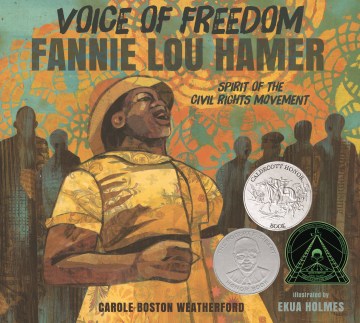Fannie Lou Hamer, an Early Civil Rights Leader
Inspiration Book:
Voice of freedom : Fannie Lou Hamer, spirit of the civil rights movement by Weatherford, Carole Boston — Candlewick Press, 2018 323; Int Lvl: 5-8. A collage-illustrated collection of free form poems describing the life and work of civil rights advocate Fannie Lou Hamer.
Rationale: We’ve had a long haul of struggle with racism this summer of 2020. The struggle has gone on far too long this summer and very definitely far too long in the history of our country. Fannie Lou Hamer was born way back in 1908 and struggled in the Civil Rights Movement of the 20th century, and the struggles continue into the 21st century. Use this book to introduce one representative of the movement. Use this book to study segments or study this book in its entirety.
There is a wonderful Teacher Guide for this Inspiration Book prepared by the people at Candlewick Press, the publisher. I wouldn’t be able to do a better job, so I chose from the activities recommended in that guide. You may choose to follow the entire guide. My choice here is to introduce the book, to introduce the topic of civil rights, and to introduce Fannie Mae Hammer. I chose poems and discussion and activities that seem to fit the summer of 2020.
Grades 5-8--Fannie’s Struggles Continue
Background: The most impact of this Inspiration Book will be for Grades 5-8 and even older. Those students will have had a little academic background and are more likely to have watched more of the news this summer and will see the connections being made.
Preparation: The Teachers’ Guide lists eight “Prereading Questions” to have the students answer, either individually or as a class. They set the tone for an introduction to the book or a study of the whole book. Save and tally the results. After introducing the book, and probably a day or two later, have students react to the questions again, and, again tally the results. Hopefully, there will be a change that you can also discuss. Even if there is no change, lack of change would be worth discussing, too.
On a scale of 1 to 5 (1 being you strongly disagree, 5 being you strongly agree), rate each of the following statements:
1. It is always worth making the sacrifice to stand up for your beliefs.12345
2. Sometimes it is impossible to forgive. 1 2 3 4 5
3. Racism no longer exists today. 1 2 3 4 5
4. There never comes a point when you should give up on a cause.12345 5. It is always better to think of other people before yourself. 1 2 3 4 5
6. All people should have a political voice. 1 2 3 4 5
7. All people should be proud of their heritage. 1 2 3 4 5
8. Violence solves some problems. 1 2 3 4 5
Decide which poems you would like to spend time discussing. The Teachers’ Guide offers discussion questions and/or for most of the poems. The poems I’ve chosen for discussion are very appropriate for the struggles of the summer of 2020.) All questions are from the Candlewick Press Guide
Introduction: (Have students take the survey as the introduction then, begin reading the book aloud.) The Inspiration Book is written in poetry. I’ve chosen only a couple of the poems to discuss, but we will read the whole book aloud.
(Stop to discuss after reading “My Mother Taught Me” p. 5 )Why was the black doll so important to Fannie Lou’s mother and to Fannie Lou? What did it represent to them?
“The Price of Freedom” p.17 What is a poll tax?
“The Beating” p. 21What do you think was included in the 1964 Civil Rights Bill? The bill was signed into law by President Lyndon B. Johnson. What does the poet mean when she says “The blood of freedom fighters was in his pen”?
“Running” p. 23 Why did Fannie Lou Hamer believe it was so important to run for office? Would you have been willing to run for Congress if you had survived the conditions she had survived?
“Freedom Summer” p. 24 What were the white student volunteers such as Michael Schwerner, James Chaney, and Andrew Goodman trying to accomplish when they went to Mississippi?
“Black Power” p. 33 How did Fannie Lou feel about Stokely Carmichael’s requirement that SNCC staff members be black? Why?
“America’s Problem” p. 34 By saying that racism was “America’s problem,” Fannie Lou Hamer wanted to make it clear that racism was not just a problem in Mississippi. Do you agree? Is racism still America’s problem today? Why or why not?
“No Rest” p. 36 The closing line of the book is “Maybe I had won after all.” What were some of the changes in the United States that Fannie Lou Hamer could consider in her victory?
Reread “Fair” p. 6 Many things described in the poem “Fair” are very unfair. (Divide your students into small groups and have them list the things that were unfair. Then discuss Jim Crow laws, which allowed and encouraged many of these things to happen in Mississippi from the 1890s until 1965.)
Redo the introductory activity. Tally and discuss the results. Do they differ? Why or why not?
Related Titles:

